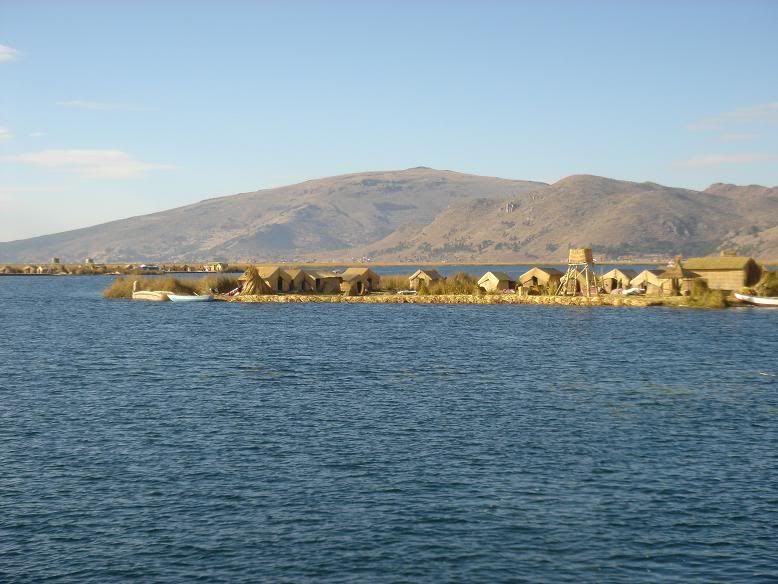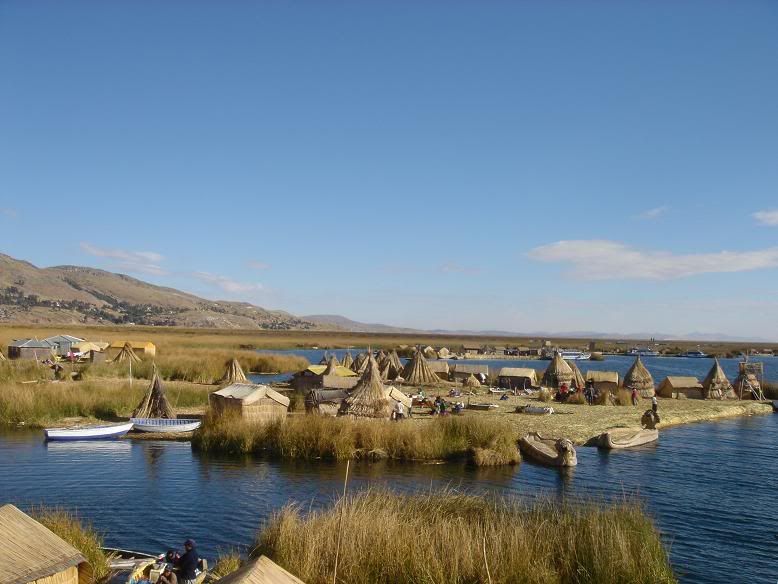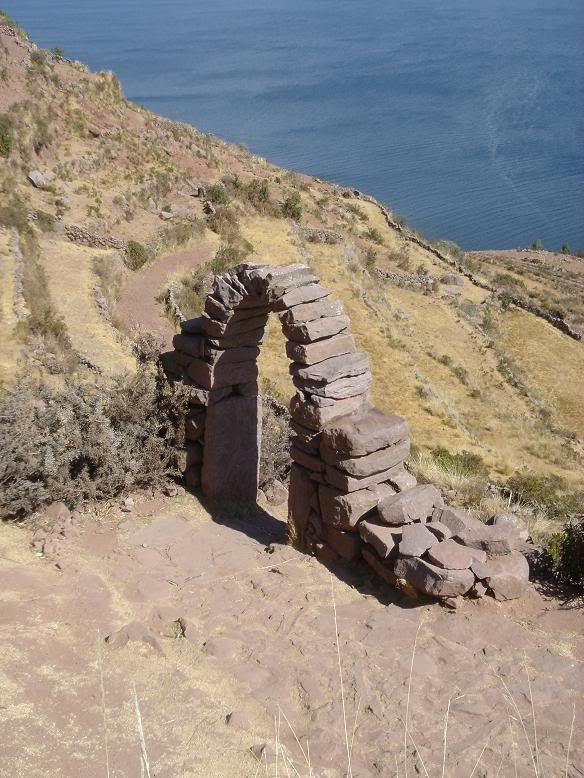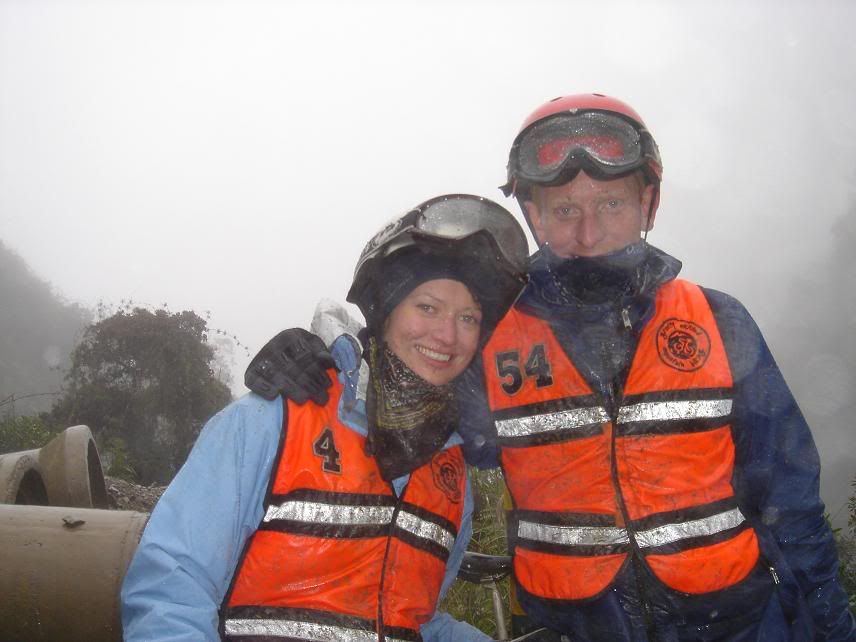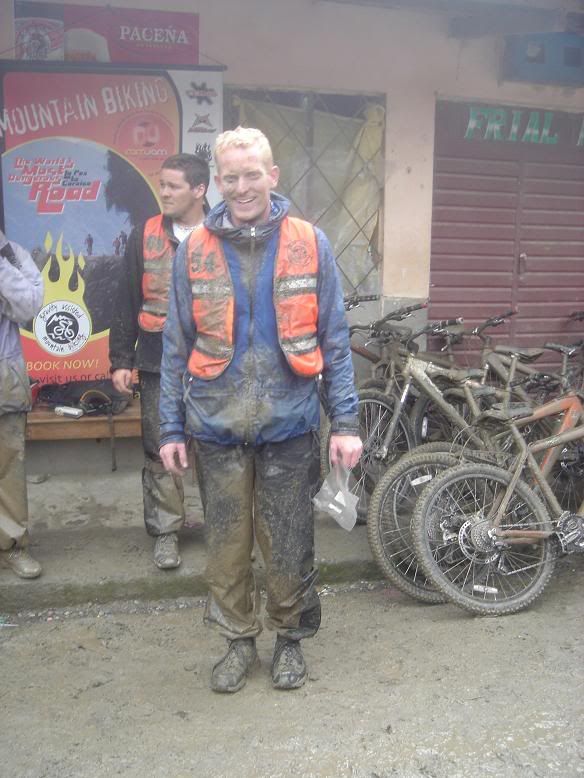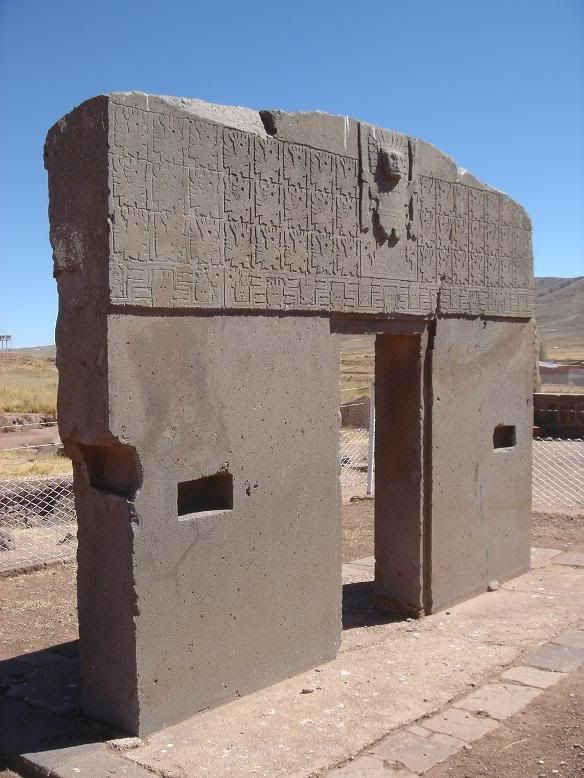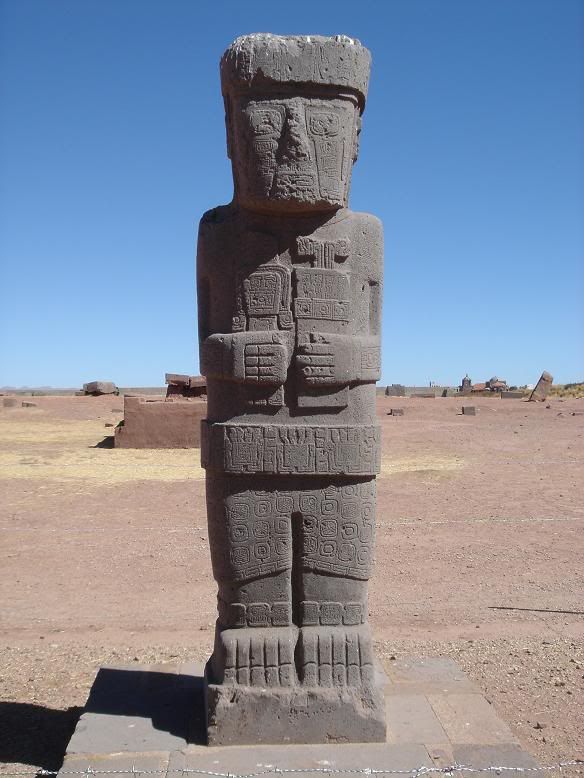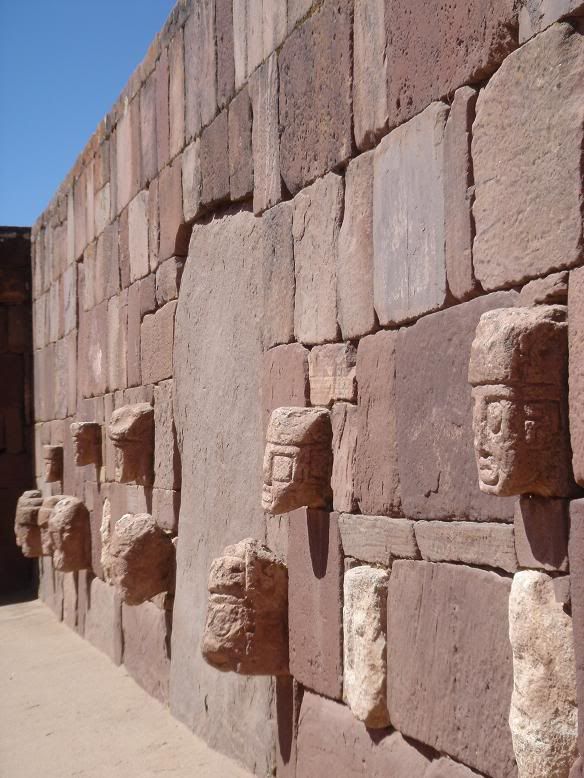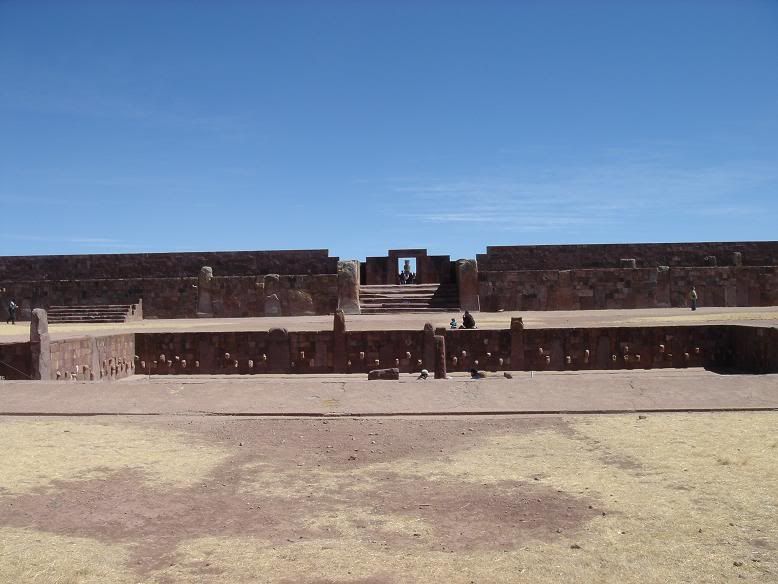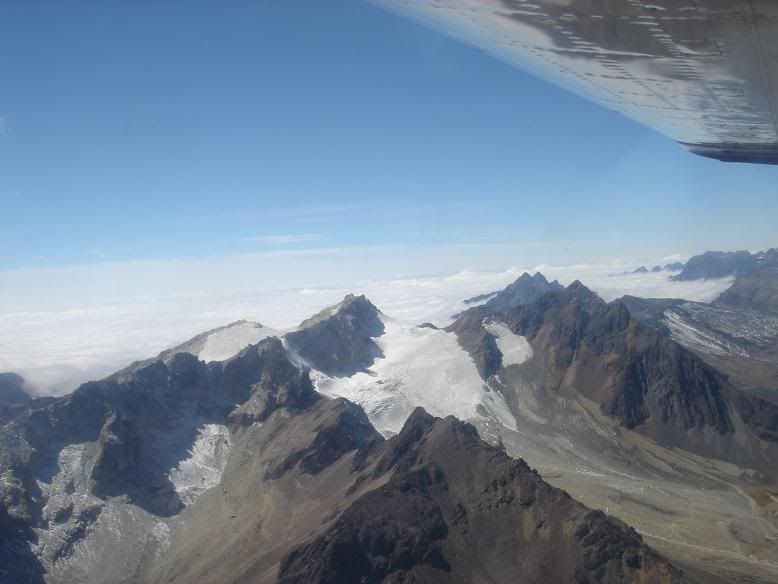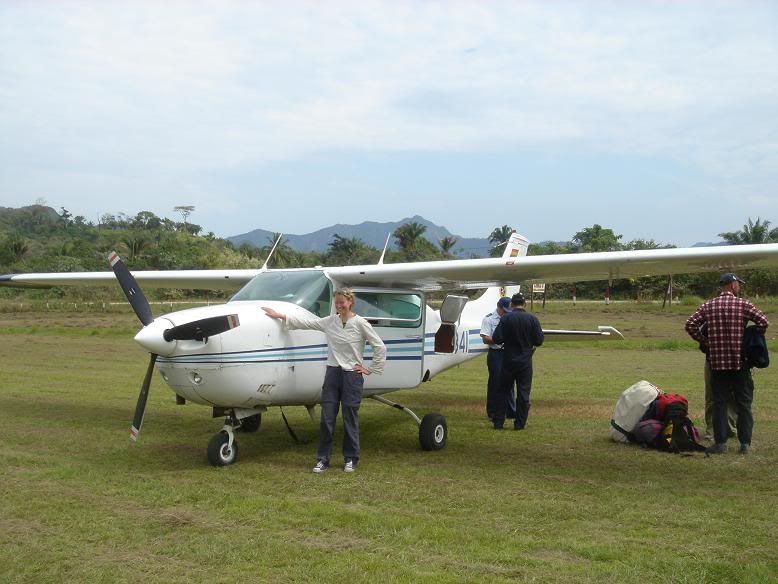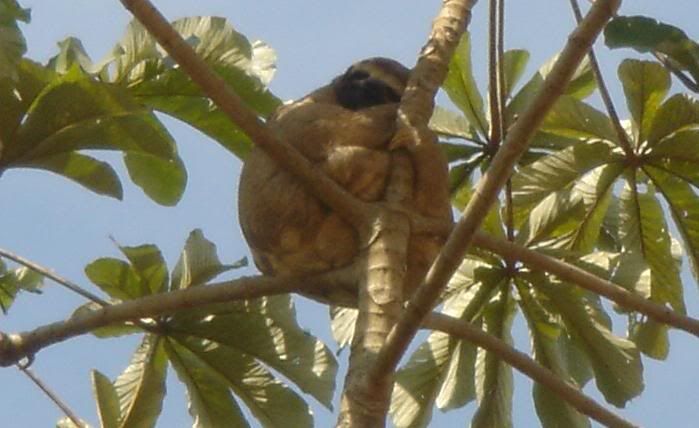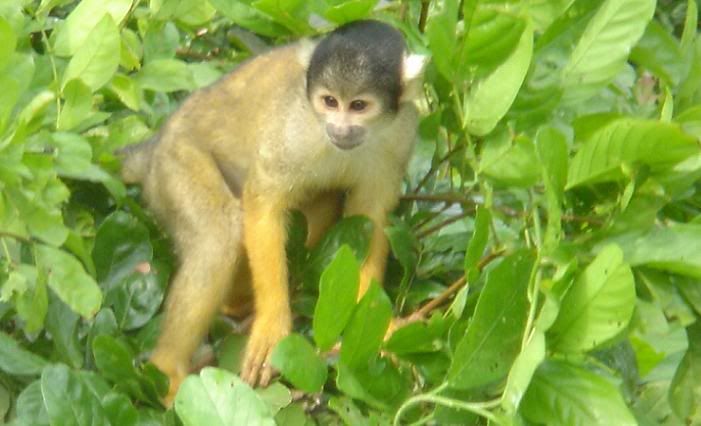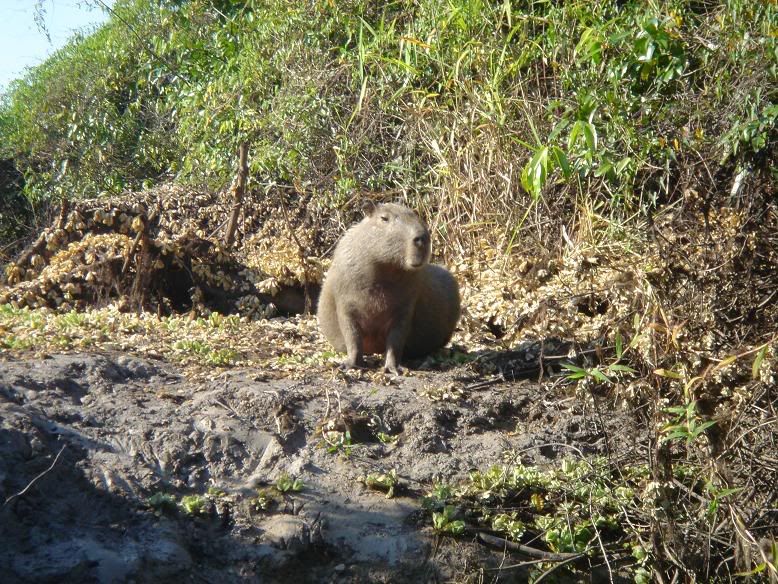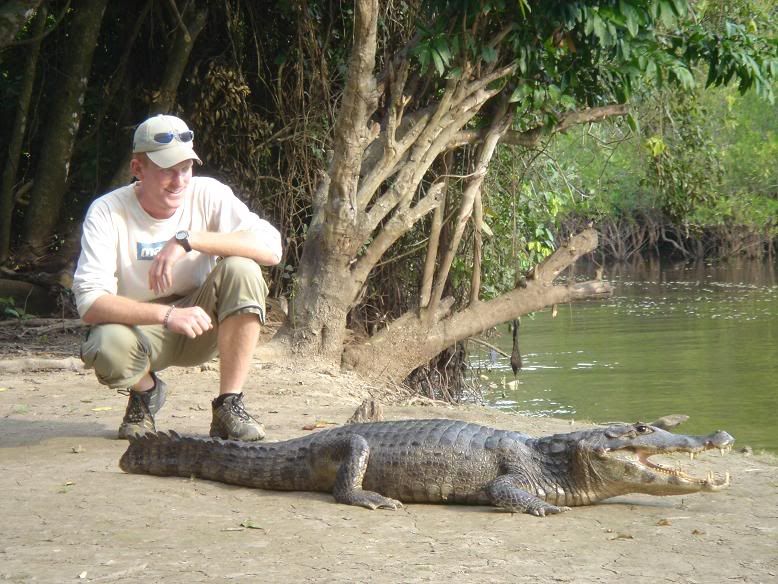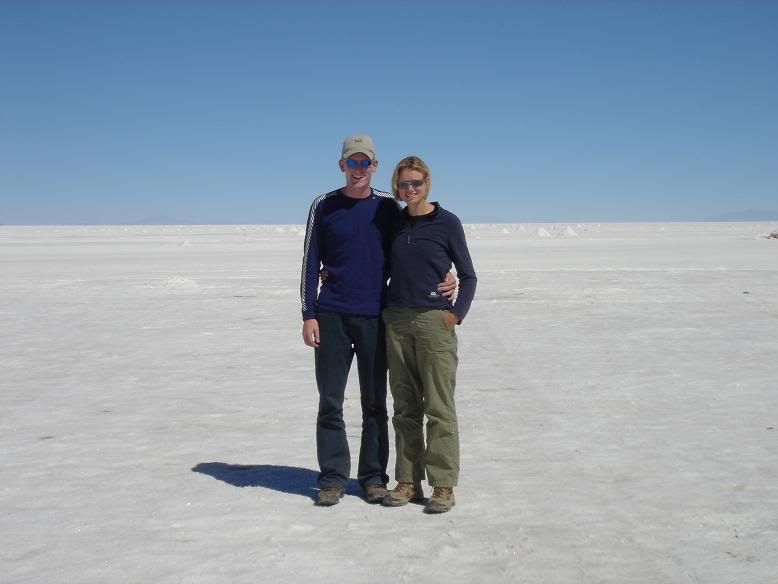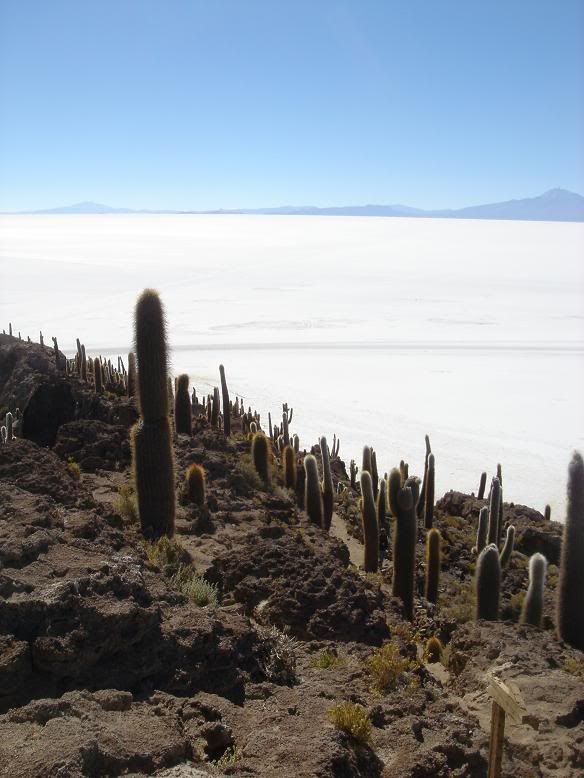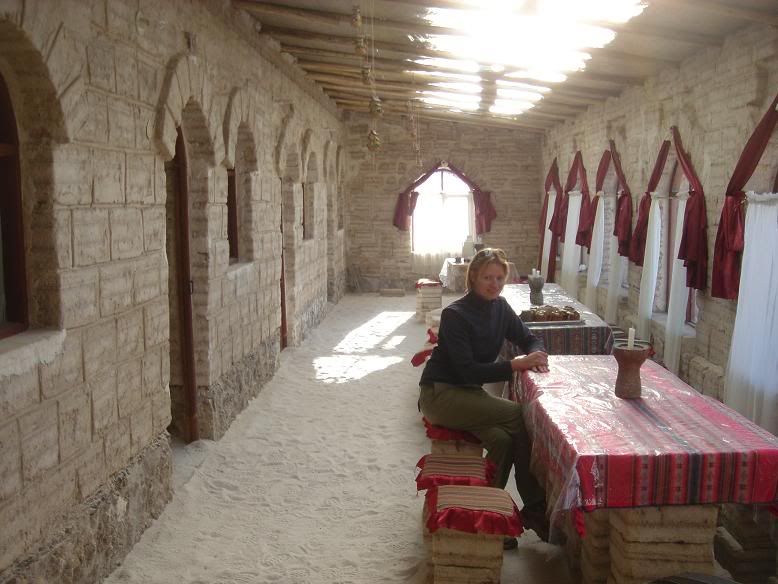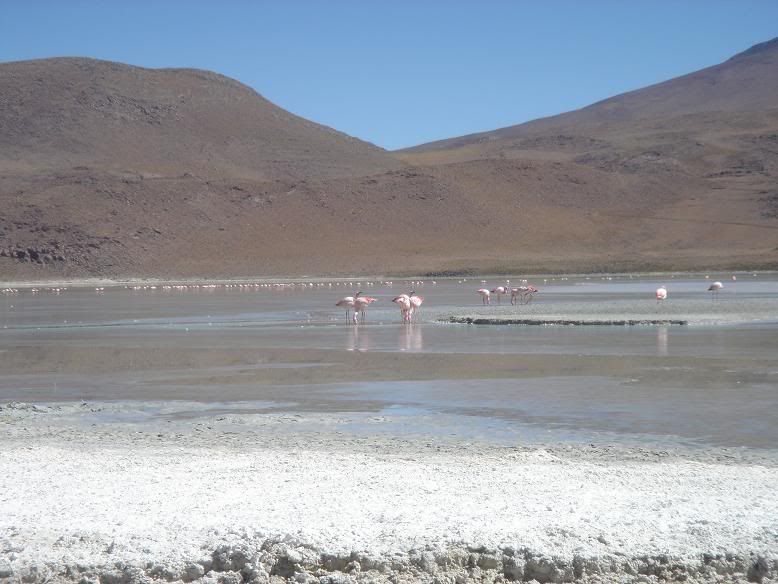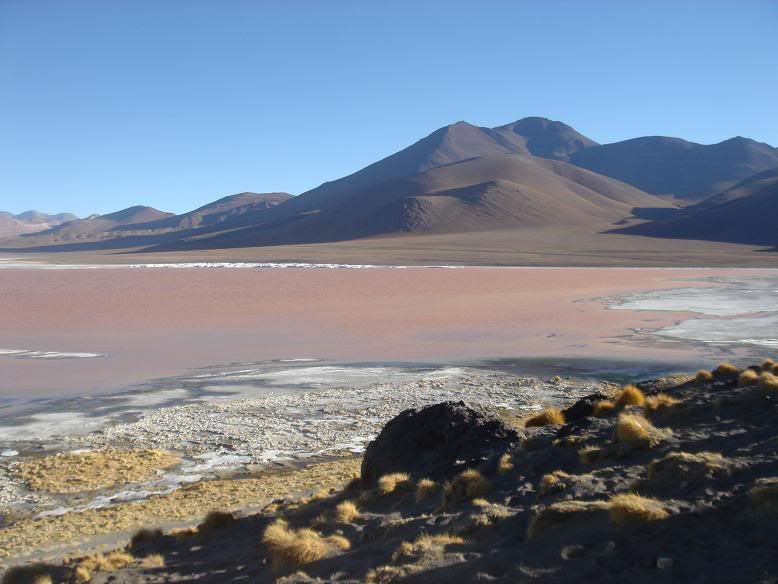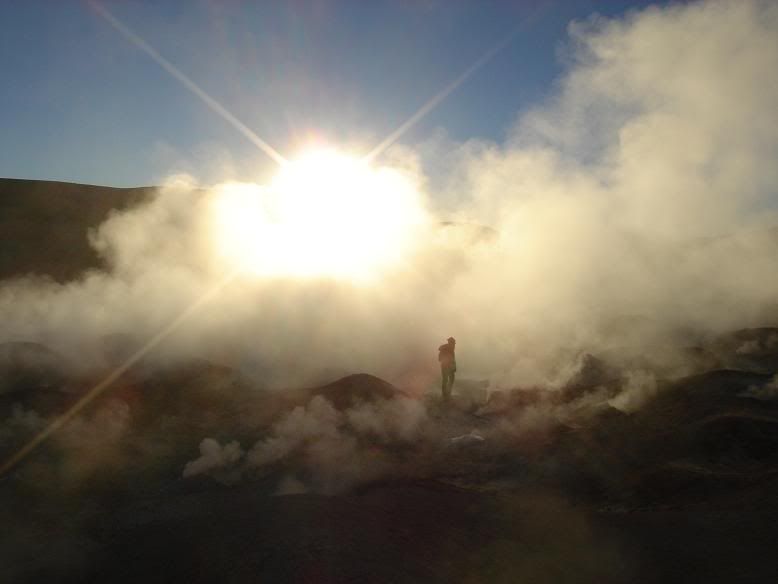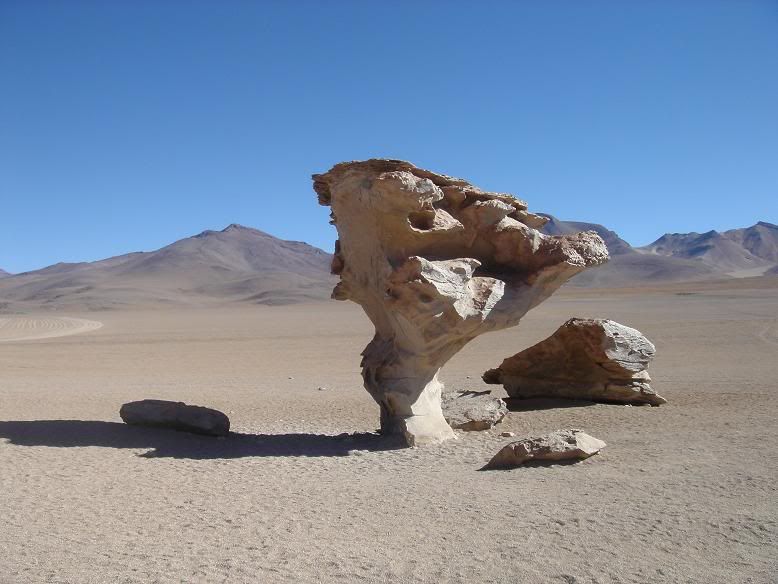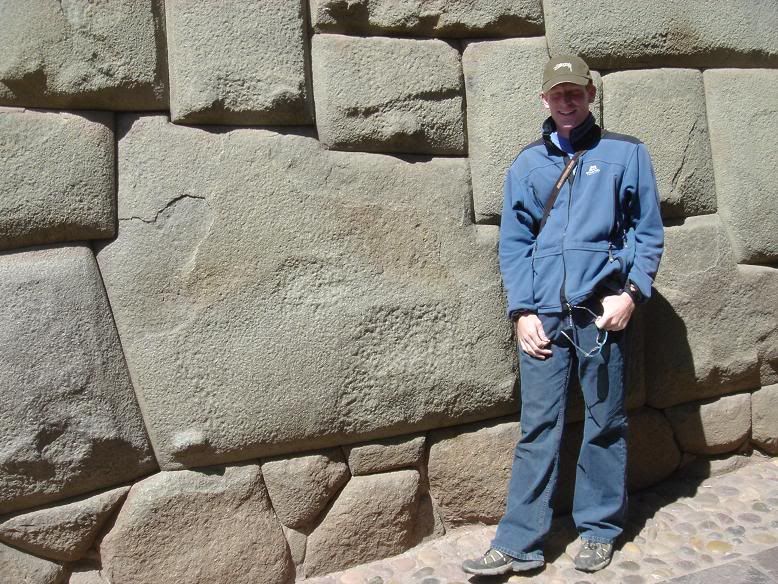
"The stone of 12 angles"
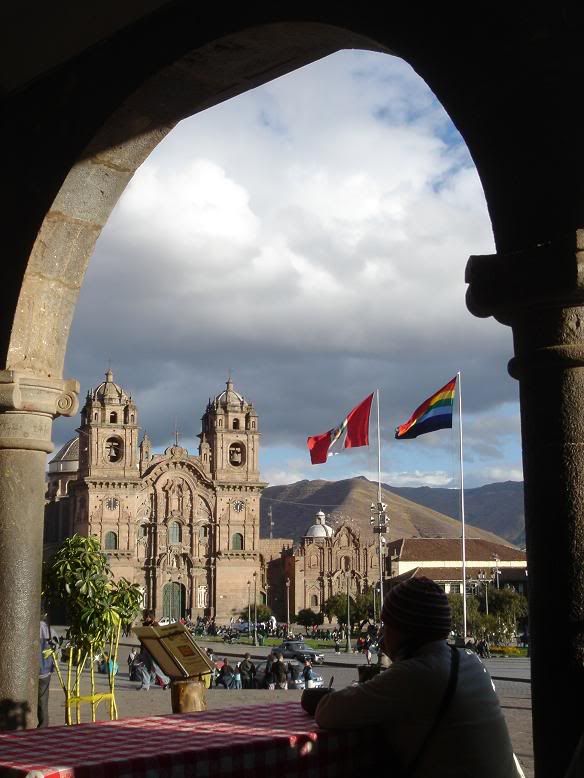
Cusco Plaza
We spent a couple of days wandering around the streets, visiting various museums, galleries and the odd church. Many buildings are built on Incan foundations - still standing strong today, and I developed a fascination with the Inca stonework that Hannah found pretty unhealthy! Many of the churches are built on old Inca temples - par for the course. We also sorted out a week long tour to the Peruvia jungle for when we returned from the Trail - a lot more pricey than the Bolivian equivalent, but we hoped it would be worth it.
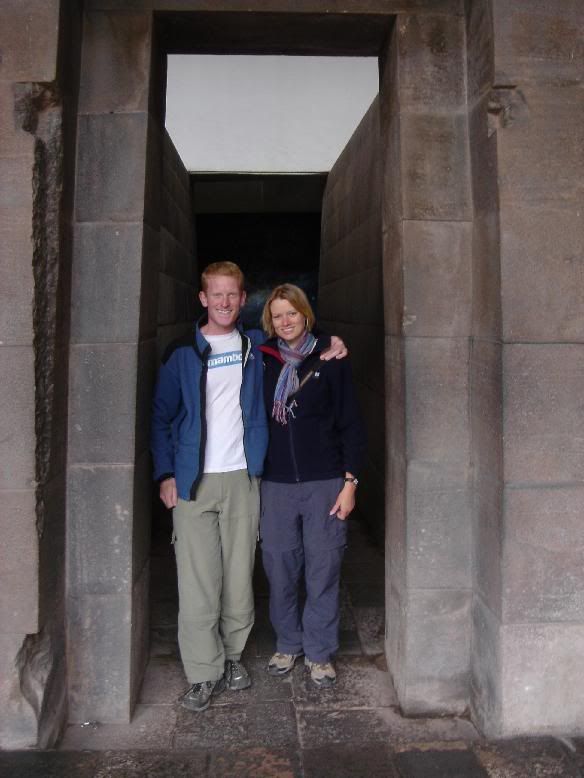
Santo Domingo church, built on top of the Incan Temple of the Sun
Our Inca Trail day did not start well - we were delayed by a few hours leaving Cusco, and finally left having collected the Italians who made up half of our group and were, we thought, the cause of our delay. We started the drive to Ollantaytambo and Km82, where the Inca Trail starts. We arrived late enough that we had lunch before we started, and then had an hour of hanging around before our guide finally reappeared - it was 4pm and we hadn't even started. There was worse.
Our guide informed us that, despite having booked up to 5 months ago (in the Italians case), our agency had not got the required permits to do the Trail (strictly limited to 200 gringos a day), none of our 12 strong group could do it. Everyone was surprisingly calm - there wasn't anything we could do about it after all, and the places are full up until October now. So we got back on the bus and headed back to Cusco - nobody wanted to do the "alternative" that the agency (Liz's Explorers, black mark it in your guidebooks!) was offering. Back in Cusco there was a full refund waiting for us, and lots of apologies - although that couldn't fix the once-in-a-lifetime opportunity that it was for the Italians, there for only 2 weeks.
Pretty philosophical, we retired to bed and the following morning set about sorting out alternative plans - we had 4 days before we left on our week long trip to Manu National Park. So after lodging a complaint with the Tourist Office, we booked 3 days of activities to explore the Sacred Valley of the Incas, plus a visit to Macchu Picchu (by train) for when we returned from Manu, and a 3 day whitewater rafing trip at the end of August. The sting in the Inca Trail tail came when we paid for various trips - the 4 $100 notes we had been given were from a batch that had had a lot of forgeries - every business in Cusco know this and were unwilling to take them, even if genuine. Whilst we accepted the error on the Trail booking, we struggle to believe that our Liz's Explorers had been unaware of currency issue, and are now giving the agency all the bad press we possibly can.
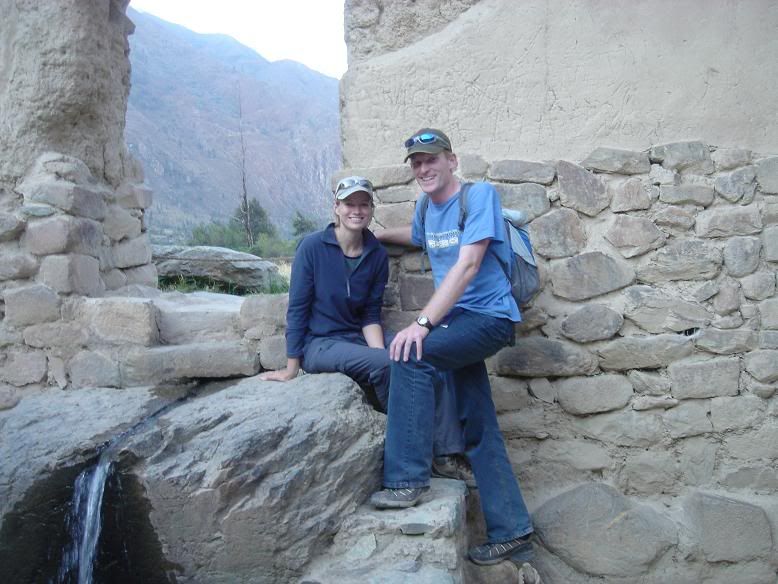
The Temple of Water, Ollantaytambo
We managed to palm off the notes eventually (they did appear to be genuine) and started looking forward to our next few days. We started out early the next morning on a tour of the Sacred Valley. We left Cusco with our friendly guide, Firmez, who was very helpful and tried to encourage us to ask questions, to the point where he finished every sentence with a 'Do you have any questions?'. On the way to our first Inca site, Pisac, Firmez pointed out several formations in the terraces; apparently one was a condor, another was Pacha Mama's (the Earth Mother) breasts - Pete and I struggled to believe any of them. Pisac was a large site with lots of terracing, apparently the Incas knew quite a lot about plant genetics, and used the terraces as a form of cultivating different varieties of plants at different atltitudes which could then be cultivated in all the different climates of the Inca empire. The stone work was certainly impressive and Pete was in his element, counting each angle, and photographing the best blocks!
Unfortunately, all the different tour agencies do the same tour around the Sacred Valley, the result being that 1000s of tourists arrive at each site at the same time so it was somewhat busy. After lunch we went to our second site, Ollantaytambo; here they had some really big blocks which Pete loved! But there also a great fountain water feature, soI got Pete to take lots of photos of it!
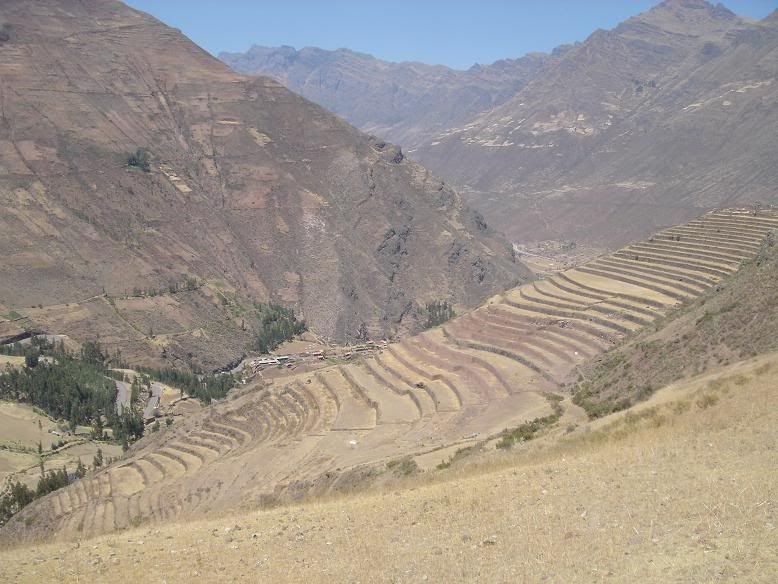
Terraces at Pisac
We then set off for our final site for the day, Chincheros, and got there just before dark to see where a church had been built on top of an old sacred Incan site - it was the least impressive of the day and the most depressing as it had been mostly destroyed.
The following day, in need of exercise, we went on a moutain bike tour to the Incan site of Moray, and the salt terraces at Maras. Pete, our guide Wilhelm and I loaded our bikes onto a bus and drove out into the countryside for an hour and then set off. We arrived at about midday to Moray; the site is an impressive set of concentric circular terraces, and there are several theories of why the Incas built it - the favourite being that it was used for plant breeding. According to some experts there is a noticeable temperature difference between each terrace, which meant the Incas could breed plants that would survive in the different climates across the Incan empire. So perhaps, Mendel, wasn't the first person to discover F1 hybrids.
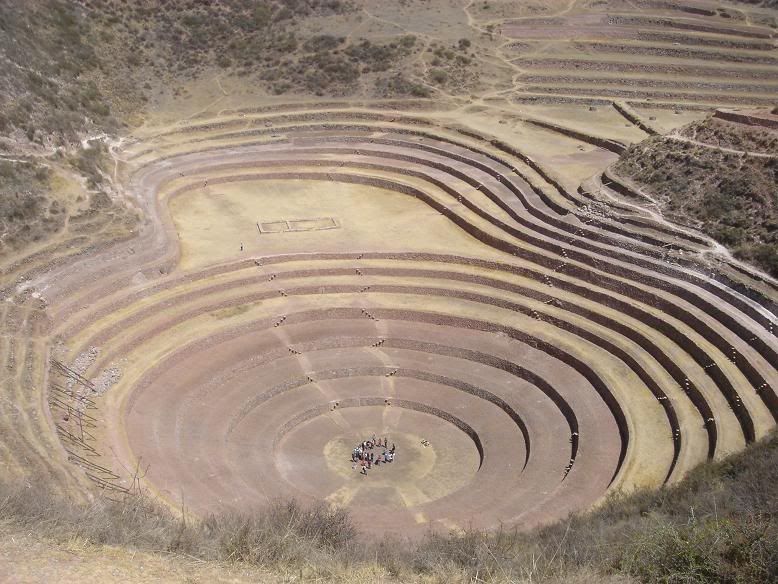
Moray
We weren't completely convinced by this theory but the site was very impressive. After a packed lunch we carried on to the salt terraces at Maras; this involved a lot of steep rutty downhills, which I found not so pleasurable on my bike which seemed to have a dodgey back brake. The salt terraces were dazzling; are a series of thousand year old terraced pools which were filled with the mineral rich waters from the surrounding mountains - the water then evaporates leaving salt. The salt is harvested by a co-op of local people.

Maras salt terraces
The following day was a relaxing horse back tour of some of the Incan sites closer to Cusco - we were accompanied by a nice English couple, a bored looking guide and several brain dead ponies. After visiting smaller Inca sites at Tambomanchay, Pukapukara and Q'enqo, we ended up at Sacsayhuaman (pronounced "sexy woman") . This vast site that sits on the hill overlooking Cusco, and was a stronghold of the Inca empire. The Spainsh conquistadores were nearly defeated there when one Inca emperor rose up and retook the site, from where he beseiged the Spanish in Cusco. It was only a desperate last gasp attack by 50 Spanish cavalry that saved their day and kept South American history on course. The amazing thing (this is Pete writing now, in case you hadn't guessed) about Sacsayhuaman is the size of the blocks used for the three tiers of ramparts - the largest block is estimated at 300 tonnes; when the largest mobile crane in the world today can't shift more than 200 tonnes, that makes it pretty impressive (to me, anyway...)! Having had our Inca ruins fill for a while we decided it was time for a change of scenery and the following day departed on our trip into the rainforest in search of the elusive Jaguar.

Sacsayhuaman
Sunday morning we arrived early at the office of Manu Ecological Adventures, the company which were organising our 8 day trip to the Manu National Reserve. We set off on the bus and drove for several hours before eventually the ecology of the area began to change, instead of dry looking pasture land with lots of Eucalptus trees we were enshrouded with mist as we entered the Elfin forests - these were characterised by low growing gnarled shrubs with lots of moss and lichen. As we started to decend in altitude the elfin forest gave way to cloud forest and Pete patiently humoured me as we insisted on stopping the bus to get out and look at some of the orchids that were precariously hanging on the trees from which they grew from. Many photographs later we returned to the bus and carried on to our first ecolodge (the definition of an ecolodge to me is a hut of wood, usually raised off the ground with a grass, or palm leaf roof). We had a comfortable first night in the relatively cool temperatures of the cloud forest.
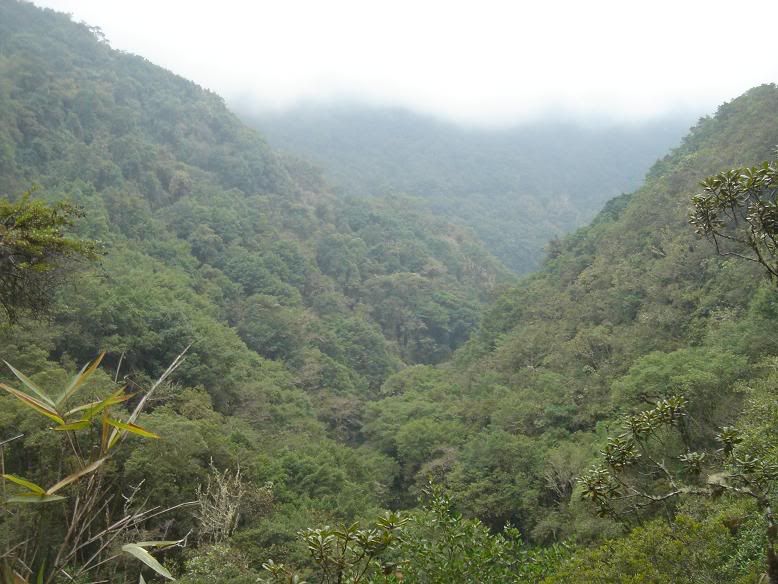
Cloud forest
The following day we got up early and walked a short distance to a bird hide to watch the infamous mating dance of the national bird of Peru, 'The-Cock-of-the-Rock'. Primitive mating rituals seem not to have changed much from birds to humans, as basically the males prance about looking a bit stupid to try and catch the attention of a female (who usually seem unimpressed and a bit above it all, no change there then). After breakfast we set off downhill on mountain bikes eventually arriving at the bottom out of the cloud forest and into the tropical "Cultural Zone" of the reserve. After a short bus ride down the road we reached a small town where we left the bus and boarded rafts to paddle down the Alto Madre de Dios (or the 'Mother of God' River) for an hour and a half or so to the point where we were to meet our trasport for the rest of the trip, motorised canoe. We loaded our bags onto the canoes and set off down stream. We arrived at our second ecolodge, 'Erika Lodge', at about lunchtime where we had a large lunch, relaxed and then went for a walk with our guide Beto - he certainly knew his birds. After a satsifying walk we saw toucans, oropendulas, parrots, woodpeckers etc. we returned back to the lodge for dinner and then set off on a night walk.
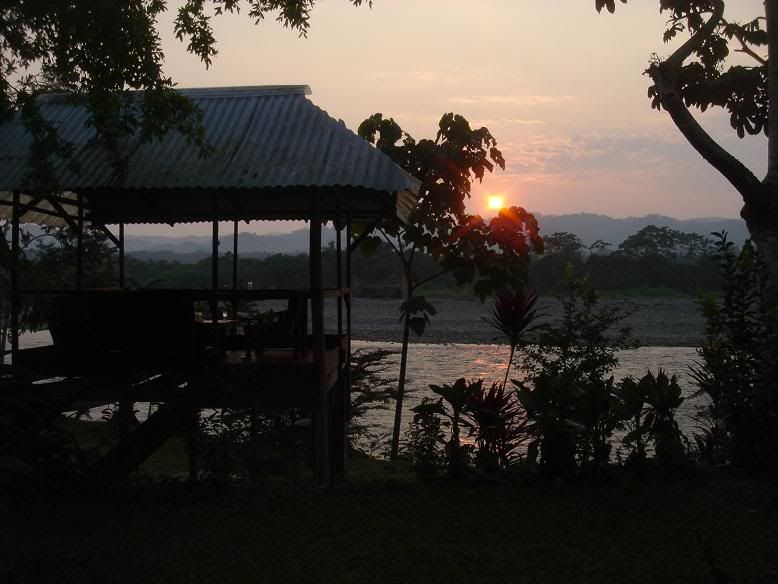
Sunset at Erika Lodge
The following day was another early start, with a walk through the surrounding forrest and jungle and then we set off once again down river in the canoes. Being the dry season occasionally the canoe would ground requiring us to jump out and give it a push. We travelled down river for several hours, eating lunch onboard, and spotting various birds en route such as neotropical cormorants, tiger herons, little blue herons, egrets, turkey vultures, red headed vulture, road side hawkes, sand coloured nighthawks, kingfishers, cowbirds, etc. We eventually arrived at Boca Manu Fitzgerald, the nerest small village to the Reserved Zone of the park. I felt it was ironic that they had named the village after Fitzgerald, who was the guy who first made a trail to the area, and then enslaved and killed half the indigneous population. After a short ride down river we reached the third ecolodge where after dinner we went for a night walk.
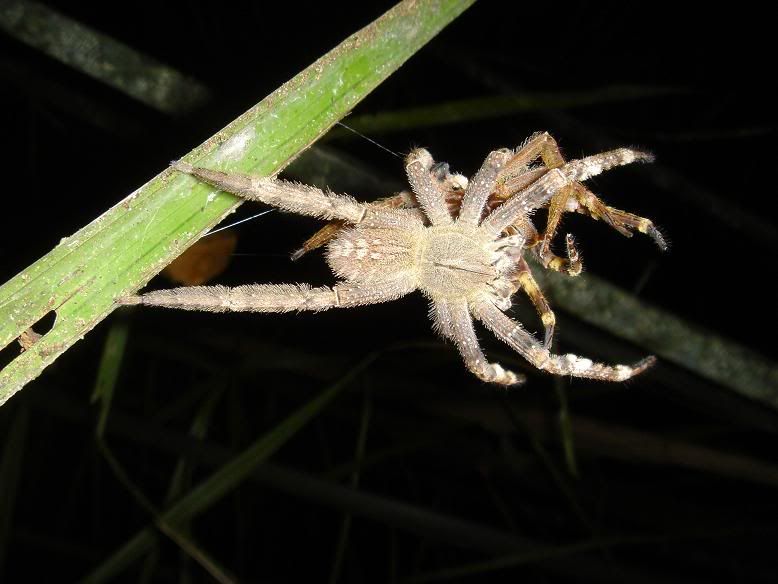
Nighttime in the jungle = big spiders
The third morning we set off early and started up the Manu river; shortly into the river we saw a flock of blue headed green parrots eating clay from the banks for the river - the ionic charges of the clay particles neutralises the high toxins the parrots receive from their diet of seeds. We travelled a bit further up river to the Limonal ranger station on the edge of the Reserved Zone where we all signed in. Back in the canoe we carried on for another 6 hours to reach our fourth ecolodge, where we were to stay for two nights. We went for a short walk to some viewing platforms which looked over an oxbow lake, spotting lots more birds, Spider monkeys, squirrel monkeys and Red howler monkeys but not the rare giant otters that live in the oxbow lakes in this part of the Amazon.

Rainforest

Our jungle lodge
The following day we walked for 2 hours or so to another ecolodge site, run by a local tribe who also sold bows and arrows and handicrafts to tourists. On the way we were passed by a herd of smelly white lipped peccaries (wild pigs), you can smell the herd of a hundred or so long before you see them. After a brief archery competition between the gringos and the locals, (shooting a papya), the gringos gave up as we were pretty rubbish, except for Pete who was so good, he was almost made an honorary tribal member.
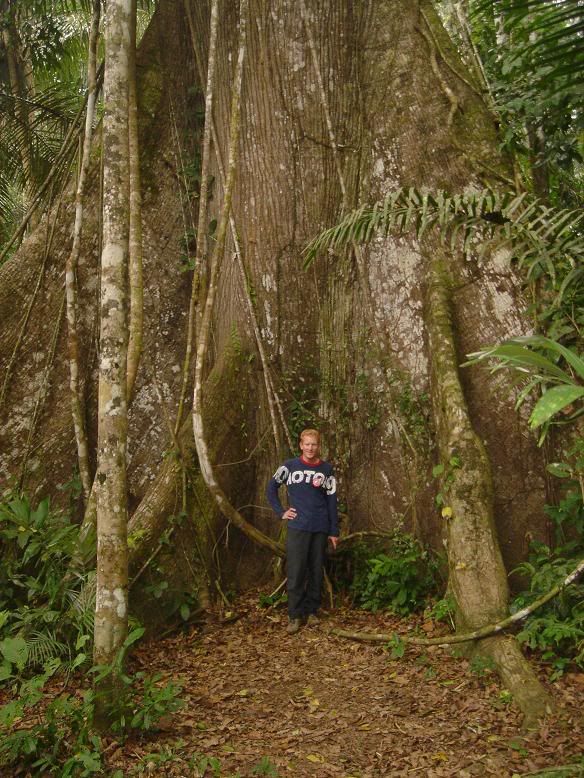
Big trees!
There are still many indigenous tribal people within the bounds of Manu National Park, which has a very strict access policy. The furthest in tourist can get is the Reserved Zone; within the main Park (almost 2 million hectares) are only allowed authorised biologists and anthropologists. After the rubber boom, the enslavement of many Indians and introduction of Western diseases, several tribes withdrew from their normal ranges and now live in "Isolation" - although they have been contacted in the past, contact is now forbidden and these people are rarely seen. Elsewhere in the Peruvian Amazon remain probably the last uncontacted tribal group in the world - an estimated 1500 people are being slowly forced from their traditional ranges in the face of illegal logging.
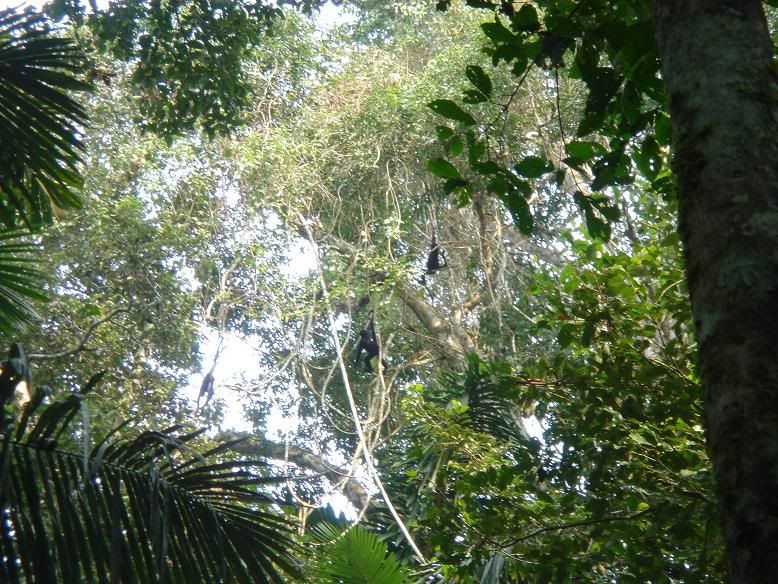
Spot the (black spider) monkeys!
Carrying on with the competitions we had a football match, the gringos this time were a bit more evenly matched. We returned back to the Ecolodge by canoe and after lunch set off back to the oxbow lake where we got on a catamaran and paddled about in search of giant otters - fortunately they weren't too far a way and we spent a couple of hours watching them playing from a distance (as they are an endangered species we could not get any closer than 50metres to them, but even from that distance they looked pretty big).
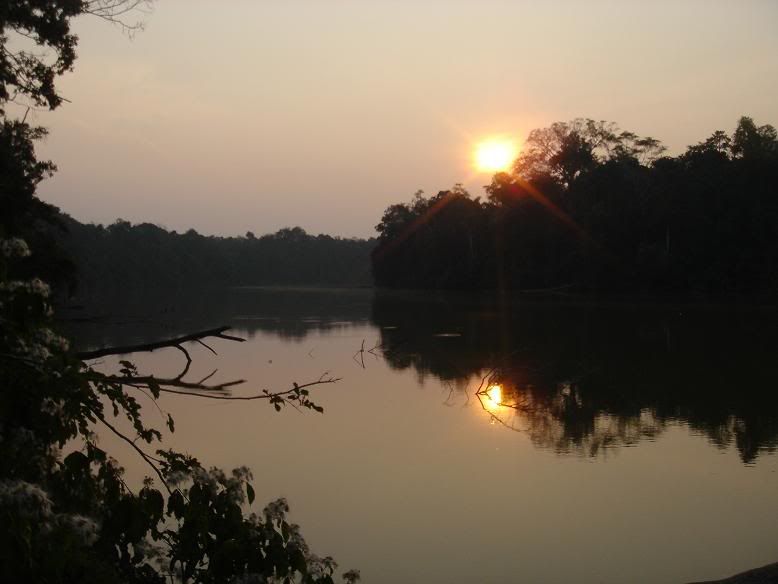
The oxbow lake
The following day we started the long trip back to Cusco, leaving our ecolodge after a morning walk and setting off down river back to Boca Manu Fitzgerald. Shortly after the leaving the Reserved Zone Pete spotted a giant ant eater (apparently they're more endangered than jaguars) and immediately after that we saw a group of capybara on the river bank having a drink. After another stay overnight in the lodge site we had stayed in previously, we got up very early to make the slow journey all the way up river back to Erika lodge. As we were going up stream, we had to get out several times a push the canoe over some of the more shallower parts of the river quite tiring when you're working agains a strong current on slippery rocks.
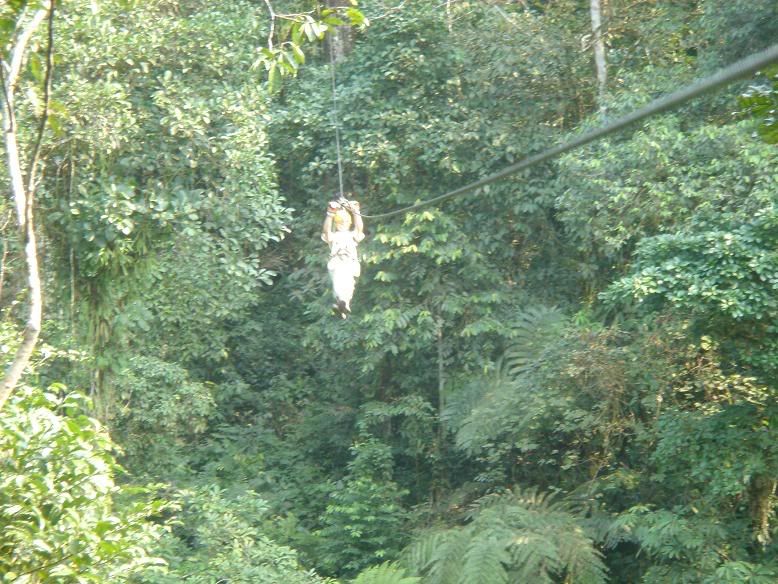
Canopying
The morning afterwards we got up at the more sensible time of 7am in order to go canopying - basically sliding on zip wires between trees at 40m up in the air. After my intial reservations of being so high, and after many assurances that it was safe from the guides and Pete, I had a go and enjoyed the view of being up in the forest canopy. We then returned to Erika lodge where we awaited the other canoe of guests to return before crossing the river to reach our bus. It was a very long drive back to Cusco, and we arrived at 3am in the morning, more than relieved to be let into our hostel at that unearthly hour.
The following morning we were up early again, doing the chores that need to be doen all the time - CD burning, laundry, ordering shoes and the like. By 4pm we were on a direct bus to Ollantaytambo, in order to get the late evening train to Aguas Calientes at the foot of Macchu Picchu. Ollantaytambo was empty when were arrived, and after buying supplies for the next day and getting dinner we got on the train with the hundred other backpackers who were doing the same. The scenery is meant to be great, but in the dark.... we arrived in Aguas Calientes and checked in to a cheap hostel, and crashed out.
The next morning we were up early again to catch the break of dawn over Macchu Picchu. We baled at the $6 bus ride so walked up, and 1 hour later and 400m higher found ourselves queueing with the hoardes of otheres who had taken the bus. By 7am we were installed at the spot from where the picture postcard view was, and eating a packed breakfast. Macchu Picchu is one of the rare places that lives up to it's hype, and despite the crowds the magnificent setting - surrounded by steep sided jungle valleys - the site had an awe-inspiring beauty.

After a rest we descended to the main site and started looking around - Macchu Picchu is one of the few places where most aspects of Inca life can be found in the same place - there are temples and terraces, barns and houses. After a short time exploring we headed over to Waynapicchu, the hill that overlooks Macchu Picchu from the other direction. There is a limit of 400 tourists per day allowed up - the Peruvians are becoming concerned that the site will lose it's World Heritage status soon due to excessive numbers of tourists and lack of perservation of the site.
It was a 30 minute, hot and gruelling climb to the top - exposed narrow paths and high step, coupled with lots of tourists made it hard work. By the time we reached the top, knees aching, we were ready for a rest and took in the view back over the site, and the surrounding river valleys. We continued on to see the Temple of the Moon and the Great Cave - a much less travelled route down some precisely cut Incan steps and involving way too much downhill for Hannah's liking. We reached the site - it was not as good as had been raved about - and started back to Macchu Picchu itself. Hannah was, by this point, suffering a sense of humour failure and was in need of bilateral knee replacements and lots of lemon meringue pie. I had (kind of) mislead her into the 3 hour round trip - "it's just 10 minutes down here" only works for so long. After way too much up and downs, we emerged back on the level at the main site and I was promising loads of treats as penance.

On top of Waynapicchu
However, after an hour long snooze on a quiet terrace and lunch, good humour was restored, and we spent another hour looking at the main temple areas and "industrial" areas of the site. I won't bore you with the details... just a few photos of the blocks. We left to walk back down to the bottom - we considered the bus but there was a small botanic garden at the bottom that Hannah wanted to visit, which we duly did. It was excellent - a real undiscovered gem - if you want to see more, have a look at Hannah's Plant Blog.
We returned to Aguas Calientes pretty tired and were amazed to find that, after the oodles of lemon meringue pie in Cusco, there was a total dearthof it in Aguas Calientes. So we settled for pnacakes and chocolate cakes, plus a late afternoon snooze then an early dinner and bed.
The following morning was another silly-o'clock awakening, this time for the train back to Ollantaytambo. It was light this time for the scenery, but this was lost on me as I slept most of the way back. In Ollantaytambo we had a great breakfast before winding our way slowly back to Cusco on a collection of local buses. Back in Cusco we managed a round of whirlwind shopping, emerging poorer but with several t-shirts, a pair of boots (custom made) and a bag. We confirmed our rafting trip and then met up with Gidi and Karin (the Israeli couple I travelled with in Venezuela), who had just arrived in Cusco. It was another early night, in preparation for our rafting trip.
Our 3 days down the canyons of the Apurimac River started well - a nice group (7 English, 1 Israeli), friendly guides, departed on time..... it was only at mid-day that, in the middle of nowhere in the mountains, did a suspension arm thing break on our bus. Further investigation revealed that all 6 bolts had sheared on the back part of the arm. Quicky enough our driver borrowed 6 bolts from other "non-essential" parts of the chassis, and using a pitifully small jack, lots of large rocks, a crowbar, brute force and body weight did we eventually fix the problem. Fixed it enough, that is (the arm was bent as well), to return to the last town where we hijacked a bus full of locals and got back on the road - 3 hours later.
We reached our start point in the canyon and quickly unloaded the bus and pumped up the rafts. The first afternoon was meant to be one of safety briefing, paddling practice and rescue techniques. However, due to the time and lack of serious rapids before the first campsite, in no time we were on the water and paddling down the cold river in the falling dusk, to our first camp of the trip.
Our camp was right by the river and as soon as we had the rafts our, we started putting up tents whilst the guides started on dinner. A short while later we were out of wetsuits and into long-sleeved everything, and being attacked by the voracious sand flies that live in the canyon. We cracked open the beer we had bought and had a nice, DEET perfumed evening and dinner.
The following morning we went some way to correcting what we missed out on the previous day – a safety briefing to start (tourists have died rafting this river, "although never with our company" - heard that before?) before more on the water instruction and paddle strokes. We still had to portage the first major rapid we came to – a Class V (on a scale of I-VI) that was too dangerous to allow us through – watching the guides come through was good enough.
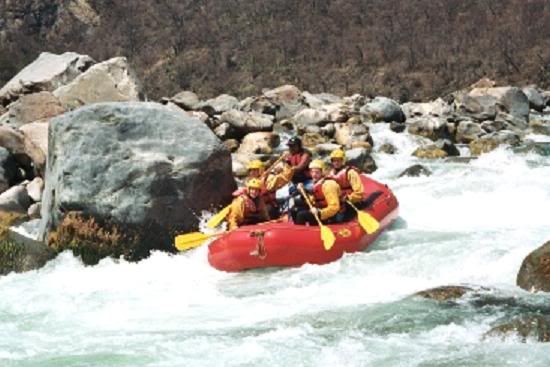
Going down some rapid....
Three hours later and we had run several Grade IV and IV+ rapids, plus surfed in a few play waves and swum down one set of rapids. We had also portaged a further 2 sets of rapids – the last being at the end of a rapid called Purgatory and the river narrowing to a gap of about 2 feet; it was a challenge to get the boats through.
As we cruised down on the raft, chatting to our guide Claudio, we nearly stopped paying attention to the river and only at the last minute did we avoid an embarrassing capsize on an easy rapid. Unfortunately, this is exactly what happened to our cargo boat – we were suddenly aware of someone swimming, and before we knew it the cargo boat was floating towards us upside down. Along with Primo, the guide from the other raft of tourists, Claudio hopped onto the upturned cargo raft to help Pedro, the cargo boat guide, right it. This was a bit harder than planned – all that baggage weighing quite a lot – and by the time they righted it we were on our way down an easy rapid without our guide.
The fallout from the capsize was not too bad except that both oars (that had been tied on) were lost, so the cargo boat was going to have a lot harder time for the next day and a half (there was one spare), and most of the “dry bags” with gear in were not what they claimed to be.
After a great lunch and some much needed sunbathing (the river is glacial, after all) we were back in the rafts, and had a great afternoon running more rapids and surfing in playwaves. I got washed out the boat once whilst on of these waves – as the kayakers out there will know, surfing standing waves is great fun but in a raft requires lots of commitment – and hence the bath. The other boat fared less well – Primo was keen to flip his boat, and with enough paddling on a play wave that’s pretty easy to do.

Our raft, on a play wave
That night we reached our camp a little earlier than planned, which was lucky as most of us had things to dry out. In the warm afternoon wind it did quickly, and we settled down to a nice night by a huge fire, with a tasty dinner and more beer (crucially not lost during the capsize).
The following morning we were up early and were soon on the water, looking forward to further IV+ rapids and play waves for surfing - the guides had fashioned a pretty Heath Robinson second oar for the cargo boat. Usually there are Grade V rapids that can be run but in the dry season the water level drops and so do the Grades. We didn’t mind this so much – that morning Hannah and I plus one other girl got washed out of our raft, and the other raft fared worse (or better, depending on your way of thinking). It was all good fun though – often retrospectively that is though, because when you’re stuck in a stopper for a few seconds and are swallowing river water, there are a lot of places you’d rather be.
All too soon we reached the end of the line – the road suddenly appeared back in the canyon and so did people – we had been alone for the past 77km. We got off the water and back onto the bus – with a leisurely break for another superb meal – and returned to Cusco for the early evening.
After that, it was all action - bags to pack, showers needed (desperately), t-shirts (more) to collect, Gidi and Karin to meet for dinner, then off to a bar to view the video footage of our rafting (hopefully available soon). We turned in late, ready for our flight to northern Peru. We had decided to bypass the entire of northern Peru in favour of longer in Ecuador – longer in this case being relative, because there’s so much left to see and so little time to do it in.
